Testing out what the best paper type is for acrylic painting and what each can do for your art projects
Canvas can get pretty expensive, especially if you are just dipping your toes into the wonderful world of acrylic painting. So, lots of artists like to turn to good ol’ fashioned paper – because it’s thin, takes up less space, comes in different sizes, and is generally less expensive to use than to their canvas cousins. Plus, you can use them with other mediums like oil paint and watercolors. #justsayin’
But, by now, you’ve probably figured out that choosing the best kind of synthetic paper for acrylic painting isn’t all entirely cut and dry.
In fact, there are several types of drawing paper out there that yield different looking paintings.
Pin it for later! ⤵

So instead of going through hours of painting sessions trying to figure out what paper type you prefer to paint with. Or buying a bajillion paper pads that end up stuffed deep inside your closet of shame. Or harassing that Michael’s employee for the 9th time to tell you all the secrets of the art world….
I will be doing the hard work for you.
We’re going to look at the good, the bad and the ugly all in an effort to help you decide which type of paper is best for your upcoming project that’ll last you a long time.
Disclaimer: some links used in this post are affiliate links, which means I’ll earn a small commission if you purchase using my links at no extra cost to you. I only recommend products I think will be helpful to you and bring you one step closer to creating beautiful acrylic masterpieces!
Common painting paper types for acrylic painting
Now, every piece of paper you ever handled have one common thing they share: weight.
Yep, knowing what your paper weight is when going into a painting is pretty important – because it can affect how well your painting withstands the “harsh” nature of water soluble acrylics and bristly brushes. Paper weight is measured in grams per square meter (or GSM for short), and for an acrylic painting project, you’ll want your paper to be at least 120GSM. And usually, the heavier paper will yield the better result.
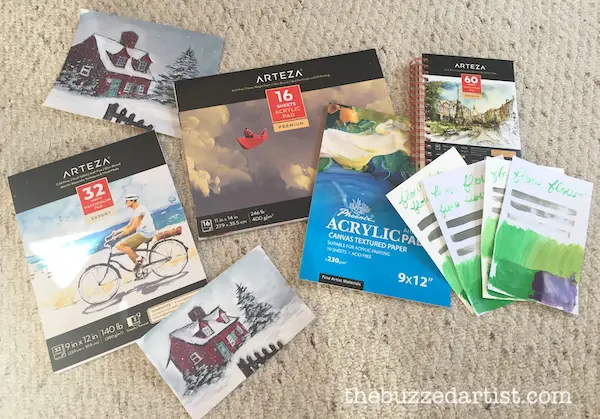
With that being said, let’s kick off this paper acrylic painting experiment to see what the best surfaces for acrylic paint is. I took 3 of the most common types of heavyweight paper used for acrylic painting and cut them into similar sizes for easy comparison.
The Paper Types We Will Be Testing
If you haven’t noticed, there are quite a few paper types, each which provide different surfaces that give differing results. For this experiment, I used the following paper types:
- Mixed wet media paper (specifically the Arteza premium mixed media pad 180gsm)
- Canvas paper (specifically the Phoenix brand 230gsm acrylic pad)
- Canvas paper (aka acrylic paper pad) (specifically the Arteza acrylic pad 400gsm)
- Watercolor paper (specifically the Arteza expert 300gsm)
As you can see from my list, I did end up testing 4 different types of paper: 1 being a heavyweight hot press watercolor paper, 1 mixed media paper, 2 different weights of canvas paper (aka acrylic pads) at varying weights.
All the items we are testing here are acid-free paper with an archival quality.
Even though I am using these specific brands of paper, the important factor is to universally show what each kind of high-quality paper can do regardless of brand. So while one art brand’s watercolor paper may be better than another brand’s watercolor paper, the comparisons to other paper types will still remain relatively similar.
Let’s dive in to see what yields the best results.
Click To Get 20% Off When You Spend $75 at Arteza
Paper Experiment Testing Criteria
Like any good experiment, I tested each paper type according to 5 specific categories that are most often encountered when painting on paper – in an effort to observe how they performed when painted on as well as how they compare to the other surfaces. The categories we tested against include the following:
- Flow
- Spreadability
- Warpage
- Blendability
- Texture
Best Paper for Acrylic Painting Experiment + Comparison Test
With our testing criteria at the ready, let’s begin the experiment to find out what the best paper for acrylic paint actually is.
Paper Criteria #1: Flow
For the flow category, I’m referring to the creation of crisp, sharp lines and how difficult or easy it is to accomplish using a detail round brush. It turns out flow can vary slightly paper to paper.
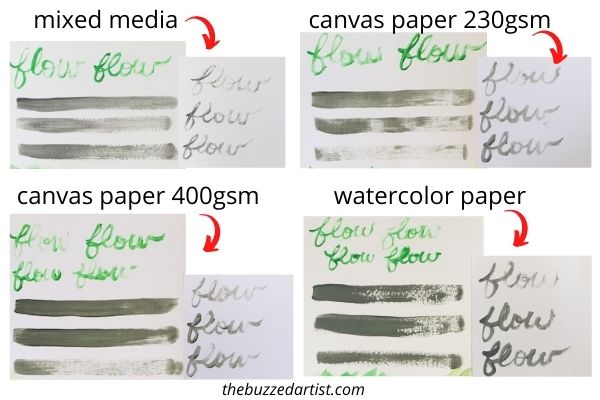
For the mixed media paper and watercolor paper, my paint was sucked into the paper and I noticed I was running out of paint ¾ of the way through. This means that I would need to reload my brush with more paint and water in order to ensure my lines stay smooth and clean.
On the other hand, when I tested on my canvas papers, I noticed the paint did not get as readily absorbed into the paper, allowing me to keep my lines crisp without needing to reload as often.
Paper Criteria #2: Spreadability
This category refers to how much paint your paper surface wants to absorb, which can lead you to use up more paint in the long run and may require a bit more work from you to get even coverage.

With the mixed media paper and watercolor paper, my paint was immediately getting sucked into the surface of the paper, and I was noticing I needed to reload much sooner. However, with both canvas papers, I could easily spread out more paint on one brush load – thereby reducing my paint consumption.
So if you want paper that gives you the best crisp clean lines and spreadability without much work or extra paint, canvas paper is a great option.
Paper Criteria #3: Warpage
In the warpage category, I decided to look at how my paper buckled and warped as I applied various painting techniques like water blending and heavy paint buildup to the paper surface.
My mixed media, 200gm and 400gsm canvas paper samples seemed to be most affected by warping, with the 200gsm canvas paper getting hit the hardest with not only warping but concentrated buckling at the very spot where I added water for blending.
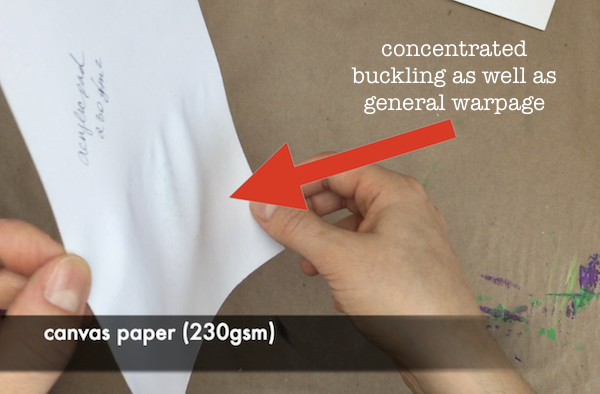
This totally makes sense especially since this paper is lighter than the 400gsm and therefore more susceptible to warpage.
But, when I was painting on the watercolor paper, I experienced minimal buckling. I barely fought with the paper and was able to evenly paint throughout the entire process, which is a godsend if you’re trying to work on specific areas and details.
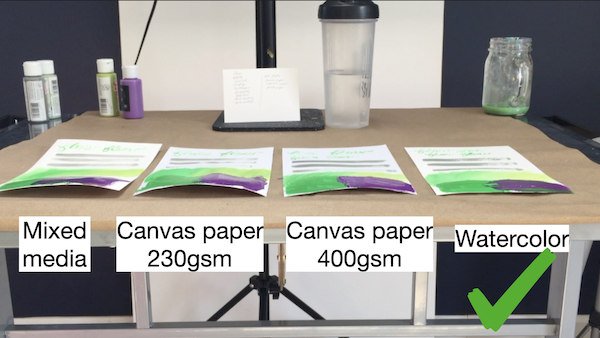
Based on the side-by-side look, watercolor paper has the least amount of warping; therefore it won by a landslide.
Paper Criteria #4: Blendability
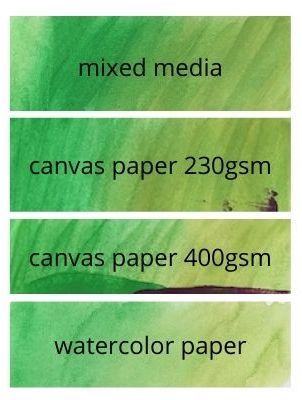
As the name suggests, the blendability category looks at how easy it is to blend colors together to get the smoothest looking blends and areas.
Compared to the canvas papers and multimedia paper, the watercolor paper blew everyone out of the water.
Watercolor paper is thick and very absorbent, allowing for paint to flow very easily for optimal blending and layering without any paper pilling or surface damage.
It’s smooth surface helps to create gorgeous smooth blends and gob on multiple layers of paint without any tear or warpage. It literally felt like magic to me.
On the other hand, trying to do a more watery blend on both the canvas papers did not bode as well because they started to deteriorate the paper surface with pilling (especially the 230gsm canvas paper).
Comparing each of the blends from the samples, the clear winner goes to watercolor paper! It’s nice to know I can use watercolor paper for acrylics as well as watercolor paints.
Paper Criteria #5: Texture
The texture category is certainly one to pay attention to, especially because it can yield different looking brush strokes and paintings depending on the paper you choose. Each paper type has a different surface texture – multimedia and watercolor paper are both fairly smooth while canvas paper mimics the surface of canvas fabric, showing thread patterns, like a linen finish.
When I painted on both the test samples and actual paintings, I noticed similar results.

For both my 200gsmm and 400gsm canvas paper, I noticed the fabric pattern show through the paint. This means that my brush strokes will appear a bit more rough since the paint wants to spread out into the rough surface of the paper surface.
Some artists love this look, because it’s appears more organic and a tad more abstract. Others don’t want the fabric pattern to show through. This is purely preference.
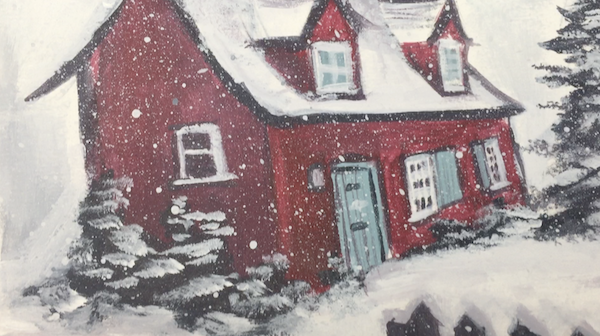

My watercolor paper texture was vastly different than that of canvas paper. Firstly, it is smooth and my lines are much more crisp. I also noticed that I could add multiple layers of paint without much trouble from the paper, helping contribute to the smoothness.
What I might use canvas paper for is more for landscapes and any paintings I prefer to paint on the looser side.
I would reserve my watercolor paper for glass-smooth painting projects like my pop art paintings and cartoon characters. Although, I would love to paint landscapes with watercolor paper too – it’s just a different painting look.
Final thoughts on the best paper for acrylic painting
So when it comes to choosing the best paper for your acrylic paintings, there are some factors you’ll want to consider, like the paper’s weight, flow, spreadability, warping, blend-ability and texture. Based off the acrylic painting paper samples, here is an easily digestible list of observations:
Canvas Paper
- Great for texture
- Uses less paint overall
- Enhances flow and spreadability
Mixed Media Paper
- Great for quick painting projects or mockups
- best used for practicing acrylic painting
- Can be combined with dry media like colored pencil or paper mache
Watercolor Paper
- Amazing blendability
- Robust with layering
- Smoother surface for a smooth paint application
- Sturdy against buckling
- More “glass-like” finish
If I had to choose a winner here, I personally fell head over heels in love with Arteza’s watercolor paper and will be using this much more for paid artwork or commissions. I loved working with thicker paper and the overall painting experience and look when using this heavy paper.
However, I do plan on continuing painting with canvas paper and other lighter weight papers too – especially if I want to make more rough, textured, or abstract paintings.
Click To Get 20% Off When You Spend $75 at Arteza
If you’re not quite sure what the right paper is for you, try getting two types and playing around with it. Observe how your brush feels against the paper surface. See how the paint glides and rests on the paper surface grooves. Whatever you like working with will be the best option for you. The important thing to know is you now have a better understanding on what each type of paper can best be used for and what your perfect surface will be in the world of acrylic painting.
Related Paper & Acrylic Paint Posts
- Arteza premium acrylic paint & mixed media paper review
- Arteza canvas pad & paint marker review
- How to transfer any image onto canvas
The Best Paper for Acrylic Painting
Pin it for later! ⤵
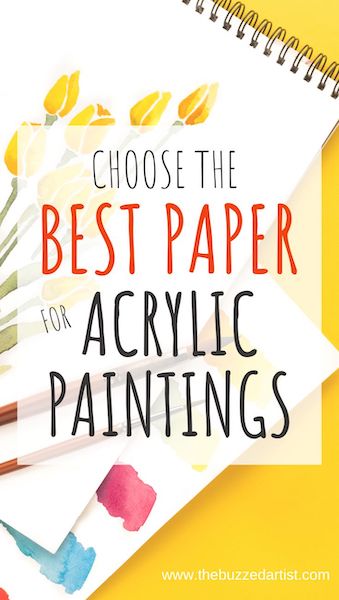
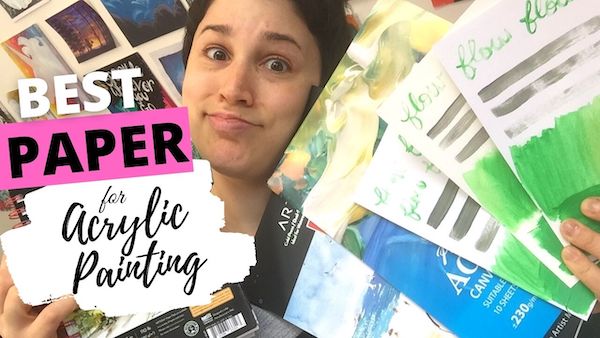




I varnish my acrylic pad sheets before I paint.
aw, that’s an interesting approach:) Thank you for sharing!
Hi Amanda,Thanks very much for all this information. I often use watercolour paper for acrylics, but I have got acrylic paper too .I’m very impressed with Arteza products -good watercolours, and great acrylic paint. I only discovered them during our lockdowns in the UK.
(I’m not getting commission for this, honest!)
Best Wishes,
Julie C
I am so glad this was helpful, Julie! Both watercolor and acrylic paper are pretty awesome and I am excited to do more stuff with watercolor paper for sure! <3 Thank you for sharing!